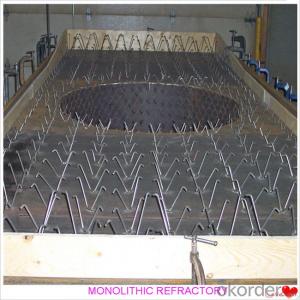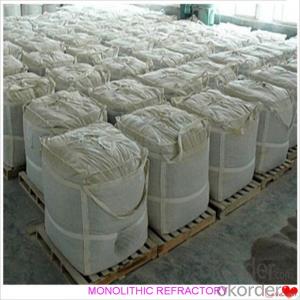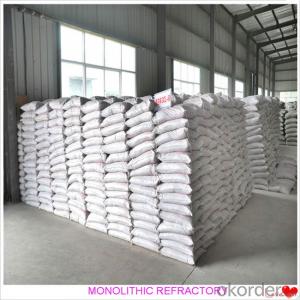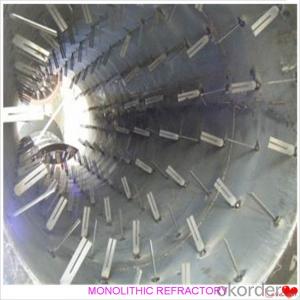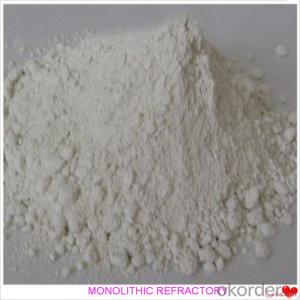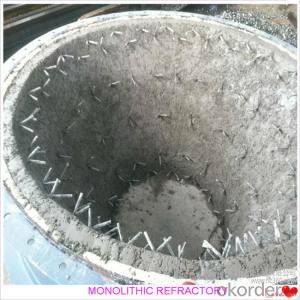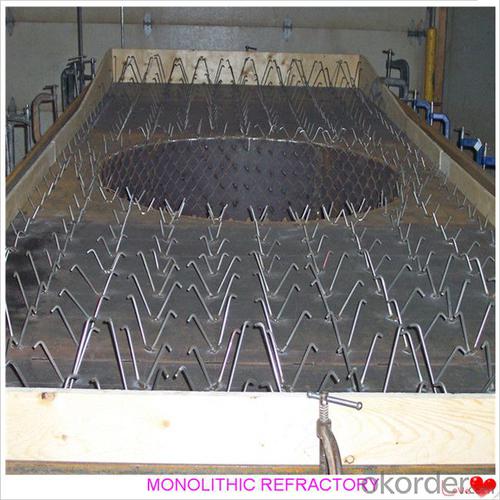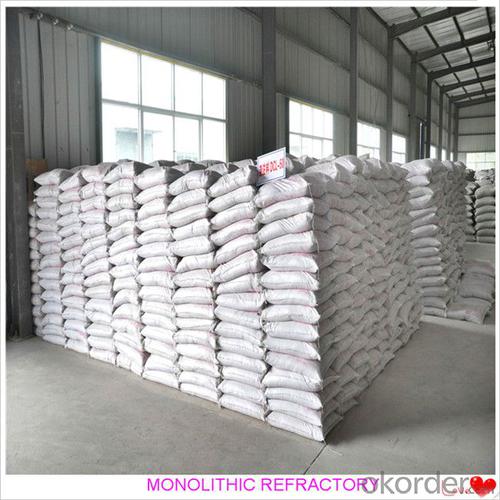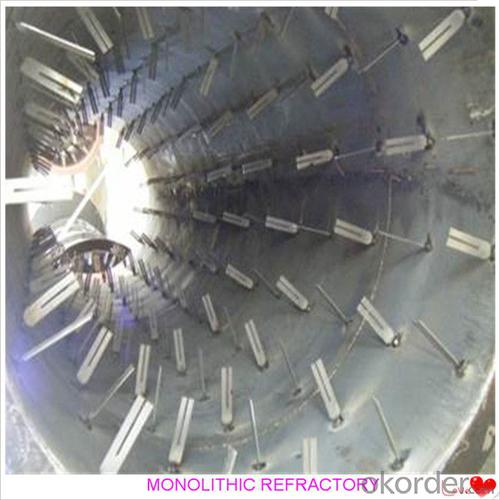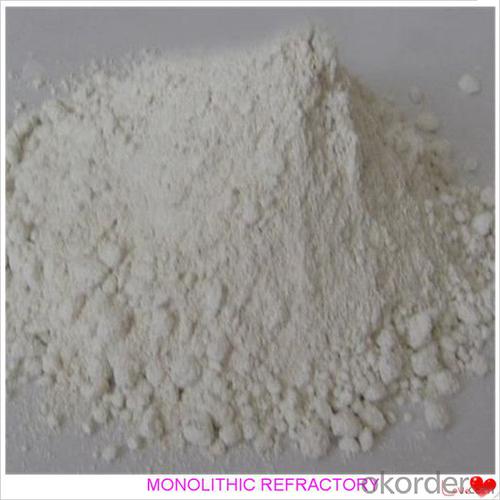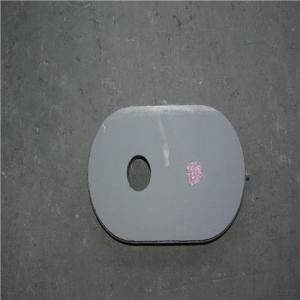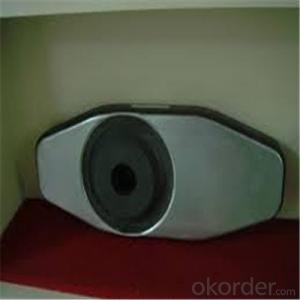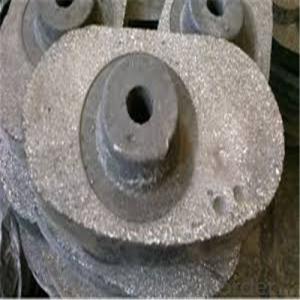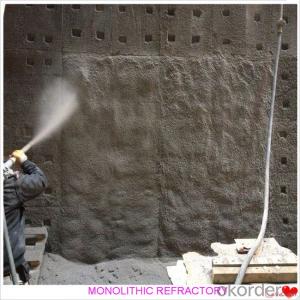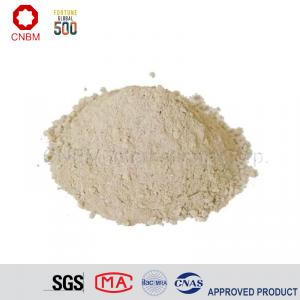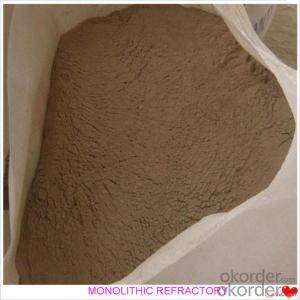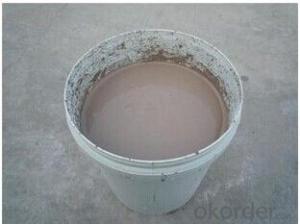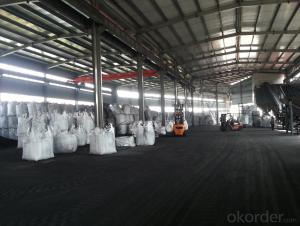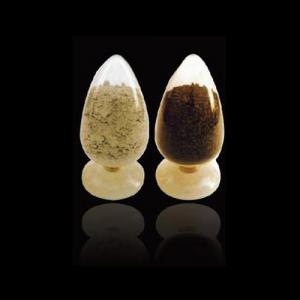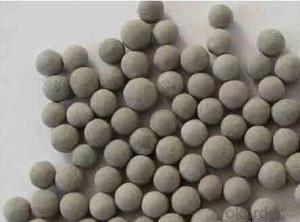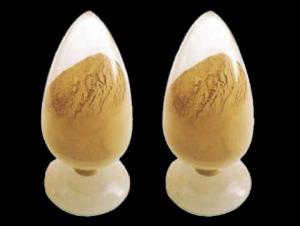Castable Refractory Cement For Fireplace and Industrial Furnace
- Loading Port:
- China main port
- Payment Terms:
- TT OR LC
- Min Order Qty:
- 1000 kg
- Supply Capability:
- 3000000 kg/month
OKorder Service Pledge
OKorder Financial Service
You Might Also Like
Castable Refractory Cement For Fireplace and Industrial Furnace
Product Description:
Gunning castable is manufactured according to international standards. The product is famous for its excellent abrasion resistance and low thermal conductivity. Further, these can be provided in different specifications as required by the clients. The gunning castables are used high purity raw materials and additives as the main material, and made of under superfine powder adding technology.
Product Advantages:
The material has excellent structural stability and air tightness, and has high physical and chemical properties, also has a fine working ability.They should be used with the same material products.
Product Applications:
For feature of gunning castable, they have excellent abrasion resistance, thermal shock resistance, high-temperature resistance, anti-corrode and have high intensity.
Designed for refractory lining of blast furnace iron and slag runners, skimmers and soon
They can be used in troughs of small and mid size BFs and in all positions of the troughs where fast tapping is required.
Product Specifications:
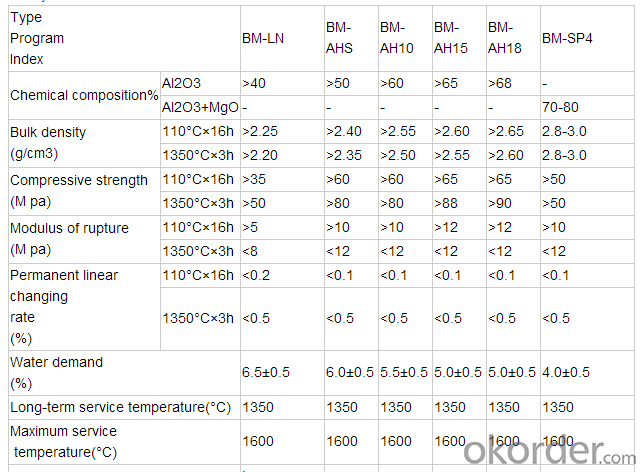
FAQ:
1. How you can control your quality?
For each production processing, we have complete QC system for the chemical composition
and Physical properties. After production, all the goods will be tested, and the quality certificate
will be shipped along with goods.
2. What's your delivery time?
It usually needs about 20days- 45 days after receiving the deposit.
3. Do you provide free samples?
Yes, we can provide a free sample for testing, If we have sample in stock,
The quantity based on the material type, The buyer should bear all the shipping costs.
4. What's your payment terms?
We can accept 30% deposit, 70% balance before shipment for ordrs over $ 2000.
5. Can we visit your Company?
Yes, certainly. You are very welcome to China and we will be honored to have a customer and friend.
Product Picture:
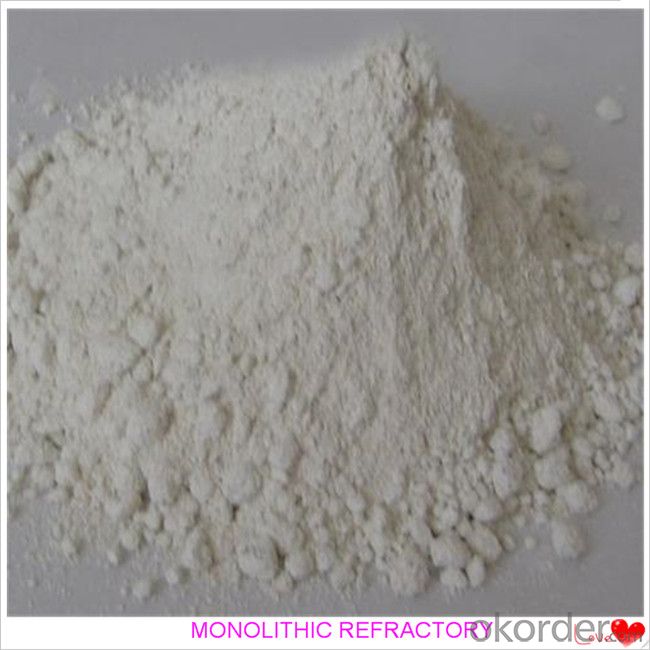
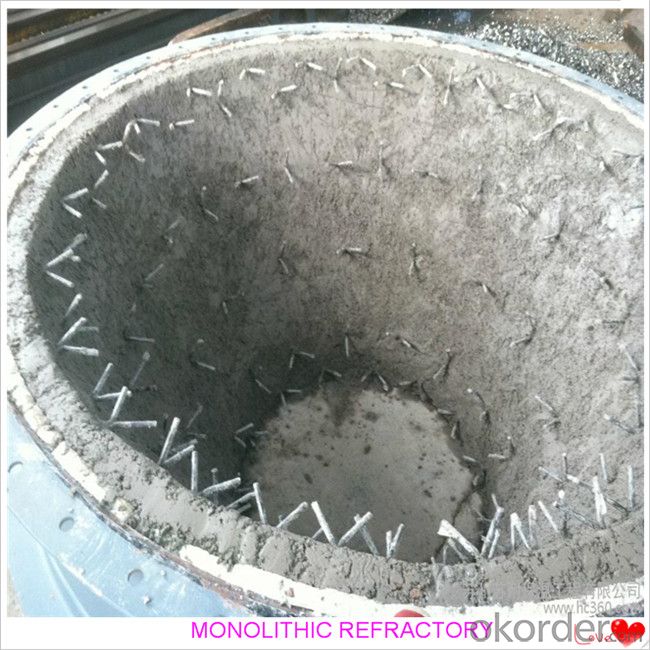
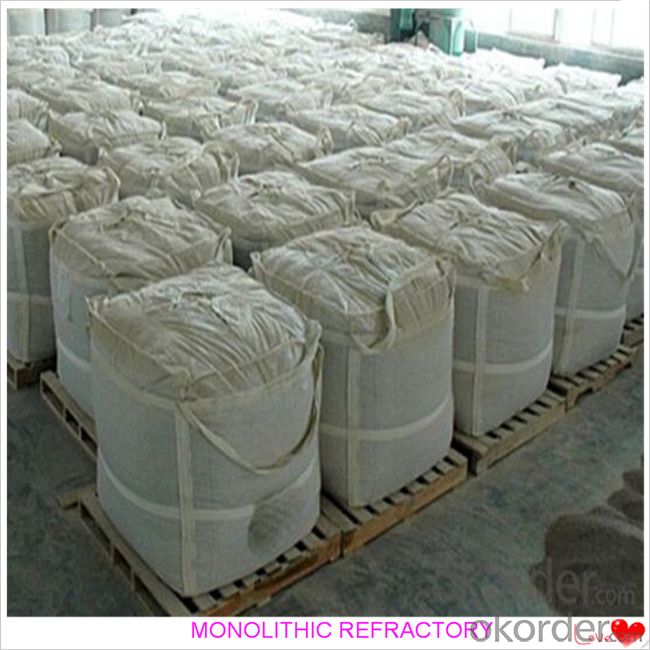

- Q: How do monolithic refractories protect lining in ladles and tundishes?
- Monolithic refractories protect lining in ladles and tundishes by forming a strong and durable barrier against the harsh conditions of high temperatures, thermal shock, and chemical corrosion. They are designed to withstand the extreme heat and mechanical stresses that occur during metal pouring and handling, ensuring the integrity and longevity of the lining. Additionally, monolithic refractories provide excellent insulation properties, reducing heat loss and conserving energy in the ladles and tundishes.
- Q: How do monolithic refractories withstand the chemical attacks in aluminum furnace applications?
- Monolithic refractories are able to withstand chemical attacks in aluminum furnace applications due to their unique composition and properties. These materials are designed to have high resistance to the corrosive effects of molten aluminum and other chemicals present in the furnace environment. Firstly, monolithic refractories are made from a combination of different minerals, such as alumina, silicon carbide, and zirconia, which have high melting points and excellent chemical stability. These minerals act as a barrier between the corrosive substances and the underlying structure, preventing them from penetrating or damaging the refractory lining. Additionally, monolithic refractories are typically formulated with high levels of alumina, which provides them with exceptional resistance to chemical attacks. Alumina has a strong affinity for oxygen, forming a stable oxide layer on the surface of the refractory material, acting as a protective barrier against corrosive elements. This oxide layer also helps to reduce the rate of penetration of corrosive substances into the refractory lining. Moreover, monolithic refractories are often designed with a dense microstructure and low porosity. This ensures that there are fewer pathways for the corrosive substances to penetrate and attack the refractory material. The denser the material, the less susceptible it is to chemical attacks. Furthermore, monolithic refractories can be further enhanced by adding additives or binders that improve their resistance to chemical attacks. These additives can include various organic or inorganic materials that provide additional protection against corrosive substances. Overall, monolithic refractories are specifically engineered to withstand the harsh conditions of aluminum furnace applications. Their unique composition, high alumina content, dense microstructure, and resistance-enhancing additives all contribute to their ability to withstand chemical attacks and prolong the lifespan of the refractory lining in aluminum furnaces.
- Q: What is the role of monolithic refractories in blast furnaces?
- Monolithic refractories have a crucial function in blast furnaces, as they offer high-temperature resistance and excellent durability in the furnace's harsh operating conditions. Blast furnaces are utilized in the ironmaking process to transform iron ore into molten iron, and monolithic refractories are essential for lining the furnace's interior. Withstanding extreme temperatures is one of the main purposes of monolithic refractories in blast furnaces. The furnace's interior can reach temperatures as high as 2,500 degrees Celsius, and monolithic refractories are specifically designed to preserve their structural integrity and shield the furnace lining from thermal shock and erosion caused by these high temperatures. Monolithic refractories also provide insulation, preventing heat loss from the furnace. This is significant as it helps to maintain the desired temperature for efficient iron production. By minimizing heat loss, monolithic refractories contribute to energy conservation and improved overall furnace performance. Another critical role of monolithic refractories is to resist chemical attack from the molten iron and slag. The materials employed in blast furnaces, such as iron ore, coke, and limestone, undergo various chemical reactions during the ironmaking process. Monolithic refractories are engineered to withstand the corrosive effects of these reactions, ensuring a longer lifespan for the furnace lining. Furthermore, monolithic refractories offer exceptional mechanical strength and resistance to abrasion. The materials processed in a blast furnace, including iron ore and coke, can be abrasive. Monolithic refractories act as a protective barrier against this abrasive action, preventing damage to the furnace lining and extending its lifespan. In conclusion, the role of monolithic refractories in blast furnaces is to endure extreme temperatures, provide insulation, resist chemical attack, and offer mechanical strength against abrasion. These properties contribute to the efficient operation and longevity of blast furnaces, enabling the production of molten iron for various industrial applications.
- Q: How do monolithic refractories enhance the performance of ladles and tundishes?
- Monolithic refractories have a crucial role in enhancing the performance of ladles and tundishes in multiple ways. To begin with, their high thermal stability and resistance to thermal shock are well-known. When ladles and tundishes are subjected to extreme temperatures and thermal cycling during the transfer of molten metal, monolithic refractories provide exceptional insulation and structural integrity. This ensures that the ladles and tundishes can endure these harsh conditions without suffering from cracks or failures. Additionally, monolithic refractories offer outstanding resistance to corrosion. In the environments of ladles and tundishes, the presence of molten metal, slag, and other chemicals can lead to corrosion and erosion of the lining. However, monolithic refractories are specifically designed to resist these corrosive agents, extending the lifespan of ladles and tundishes and reducing the need for frequent repairs or replacements. Another advantage of monolithic refractories lies in their ability to form a seamless and tight lining. Unlike traditional brick or tile linings, which can deteriorate over time due to joints, monolithic refractories are typically applied as a single, continuous layer. This seamless lining significantly reduces the risk of metal and slag penetration, ensuring better containment of the molten metal and preventing contamination. Furthermore, monolithic refractories offer versatility and ease of installation. They can be easily shaped and applied to various complex geometries, allowing for customized linings in ladles and tundishes. This versatility also enables faster installation and reduces downtime during maintenance and repairs. In conclusion, the utilization of monolithic refractories in ladles and tundishes leads to improved performance, increased operational efficiency, and reduced costs. Their ability to withstand extreme temperatures, resist corrosion, provide a tight lining, and offer ease of installation makes them the preferred choice in the steel and foundry industries.
- Q: How are monolithic refractories used in the repair and maintenance of ladle and tundish linings?
- Monolithic refractories are a type of refractory material that is commonly used in the repair and maintenance of ladle and tundish linings in the steel industry. These linings are crucial components of ladles and tundishes, which are used for the transportation and treatment of molten metal during the steelmaking process. When ladle and tundish linings are subjected to high temperatures and corrosive environments, they can deteriorate over time. This deterioration can lead to various issues such as heat loss, contamination of molten metal, and reduced refractory lining lifespan. To address these problems, monolithic refractories are used as repair and maintenance materials. Monolithic refractories are typically made from a combination of different refractory aggregates, binders, and additives. They are available in various forms, such as castables, gunning mixes, and ramming mixes. These materials are designed to be easily applied and shaped to conform to the specific geometry and dimensions of the ladle or tundish lining. During the repair process, the damaged areas of the lining are removed, and the monolithic refractories are then applied to these areas. Castables can be poured and vibrated into place, while gunning mixes can be sprayed using a high-pressure gunning machine. Ramming mixes, on the other hand, are manually compacted into the lining using a ramming tool. Monolithic refractories offer several advantages in the repair and maintenance of ladle and tundish linings. Firstly, their flexibility allows for easy installation and shaping, ensuring a snug fit to the lining. This helps to maximize the effectiveness of the refractory lining in preventing heat loss and maintaining the integrity of the ladle or tundish. Secondly, monolithic refractories have excellent thermal shock resistance and resistance to chemical attack. This makes them highly durable and capable of withstanding the harsh conditions encountered in ladles and tundishes. They can withstand repeated heating and cooling cycles without cracking or spalling, providing long-lasting protection to the lining. Lastly, monolithic refractories can be easily repaired and replaced when necessary. Their application and removal processes are relatively straightforward, allowing for efficient maintenance of ladle and tundish linings. This helps to minimize downtime and maintain the overall productivity of the steelmaking process. In conclusion, monolithic refractories play a crucial role in the repair and maintenance of ladle and tundish linings. Their ease of application, excellent thermal shock resistance, and resistance to chemical attack make them ideal materials for extending the lifespan and optimizing the performance of these linings in the steel industry.
- Q: How do monolithic refractories resist thermal shock in the iron and steel industry?
- Monolithic refractories are specifically designed to resist thermal shock in the iron and steel industry. This is primarily achieved through their unique composition and structure. Firstly, monolithic refractories are made from high-quality raw materials, such as alumina, magnesia, and silica, which have excellent thermal properties. These materials are carefully selected to provide a high melting point, low thermal conductivity, and good thermal expansion characteristics. Secondly, the manufacturing process of monolithic refractories involves precise control of the grain size distribution and the addition of bonding agents. This results in a dense and homogeneous structure, which enhances their resistance to thermal shock. The bonding agents also play a crucial role in enhancing the refractory's strength and integrity. Additionally, monolithic refractories are often formulated with additives that provide increased resistance to thermal shock. These additives can include zirconia, silicon carbide, or graphite, which improve the refractory's ability to withstand rapid temperature changes. Moreover, monolithic refractories are designed to have low porosity, reducing the penetration of molten metal or slag into the material. This helps to prevent the formation of cracks and spalling, which can occur due to thermal shock. Furthermore, monolithic refractories are often applied as a lining or coating on the surface of the furnace or other equipment. This allows them to form a protective barrier, reducing direct exposure to extreme temperatures and thermal cycling. Overall, the combination of high-quality raw materials, careful manufacturing processes, additives, low porosity, and proper application techniques make monolithic refractories highly resistant to thermal shock in the iron and steel industry. They can withstand rapid temperature changes, prevent cracks, and maintain their structural integrity, ensuring reliable and efficient operation of furnaces and other equipment in this demanding industry.
- Q: What are the key considerations when selecting monolithic refractories for tundish applications?
- When choosing monolithic refractories for tundish applications, there are several important factors to take into account. Firstly, it is crucial to consider the refractory material's ability to withstand thermal shocks. Tundishes experience drastic changes in temperature as molten metal is poured in and drained out. If the refractory material is not resistant to thermal shocks, it will deteriorate quickly and fail, resulting in expensive repairs and downtime. Another important factor is the material's resistance to chemical attacks. Tundishes often come into contact with aggressive chemical environments due to the presence of molten metal and various slag compositions. The refractory material must be capable of enduring these corrosive elements and maintaining its integrity over time. Furthermore, the mechanical strength of the refractory material is essential. Tundishes are subjected to physical stresses, including the weight of the molten metal and the movement of the tundish itself. A weak refractory material is prone to cracking and failure, which can compromise the overall performance and lifespan of the tundish. The ease of installation and repair should also be taken into consideration. Monolithic refractories are typically cast or gunned in place, so it is important to select a material that can be easily applied and shaped to fit the tundish design. Additionally, if repairs are required, the refractory material should allow for patching or replacement without causing significant disruptions to operations. Lastly, cost is always a factor to consider. While it is important to choose a high-quality refractory material that meets the specific requirements of the tundish, the overall cost-effectiveness must be evaluated. This includes considering the initial material cost, installation and repair expenses, and the expected lifespan of the refractory. To summarize, the key considerations when selecting monolithic refractories for tundish applications are thermal shock resistance, chemical resistance, mechanical strength, ease of installation and repair, and cost-effectiveness. By carefully assessing these factors, one can choose a refractory material that will deliver optimal performance and durability in tundish applications.
- Q: How do monolithic refractories prevent thermal shock in the iron and steel industry?
- Monolithic refractories play a crucial role in preventing thermal shock in the iron and steel industry by providing a high level of thermal insulation and resistance to extreme temperatures. Thermal shock occurs when there is a rapid and drastic change in temperature, causing stress and cracking in the refractory lining. In the iron and steel industry, where temperatures can reach several thousand degrees Celsius, the risk of thermal shock is particularly high. Monolithic refractories help prevent thermal shock by having a low thermal conductivity, which means they are able to insulate against rapid temperature changes. This insulation property allows them to withstand the extreme temperatures of the iron and steel production process without compromising their structural integrity. Furthermore, monolithic refractories are designed to have a high thermal shock resistance. This means that they can absorb and distribute the thermal stresses caused by temperature fluctuations, minimizing the risk of cracking or spalling. In addition to their thermal insulation and shock resistance properties, monolithic refractories also have excellent corrosion and erosion resistance. This is particularly important in the iron and steel industry, where the production environment is highly corrosive due to the presence of molten metals, slag, and gases. By providing a reliable and durable lining in the furnaces, ladles, and other equipment used in the iron and steel industry, monolithic refractories ensure that thermal shock is minimized. This, in turn, helps to maintain the efficiency and productivity of the production process, as well as prolong the lifespan of the equipment.
- Q: How do monolithic refractories withstand the mechanical impacts in ladle lip applications?
- Monolithic refractories are able to withstand mechanical impacts in ladle lip applications due to their high density, strength, and resistance to thermal shock. These refractories are designed to have excellent impact resistance, preventing any cracks or fractures from occurring when the ladle is being handled or poured. Additionally, they have a high refractoriness, ensuring that they can withstand the extreme temperatures experienced during the metal pouring process.
- Q: How do monolithic refractories provide thermal insulation in the iron and steel industry?
- The iron and steel industry heavily relies on monolithic refractories for thermal insulation. These refractories are extensively used to line furnaces and other high-temperature equipment involved in the production processes. Monolithic refractories excel in thermal insulation due to their ability to withstand extreme temperatures without degradation or melting. They are specifically designed to resist high heat, enabling their usage in environments with temperatures reaching several thousand degrees Celsius. By enduring such extreme conditions, these refractories effectively prevent heat transfer to the surrounding structure, thereby ensuring insulation. Another key aspect of monolithic refractories' thermal insulation is their low thermal conductivity. These materials possess a low thermal conductivity, rendering them inefficient in conducting heat. Instead, they trap heat within their structure and minimize its transfer to the surrounding equipment or environment. This characteristic is instrumental in maintaining optimal temperatures inside furnaces and other high-temperature equipment, enabling efficient and controlled metal production. Moreover, monolithic refractories can be applied as a thick lining layer, further establishing an additional barrier between the high-temperature environment and the surrounding equipment. The thickness of the refractory lining acts as a buffer, reducing heat transfer and mitigating the impact of high temperatures on the structural integrity of the equipment. In addition to providing thermal insulation, monolithic refractories also exhibit exceptional resistance to chemical attack and mechanical wear, which are common challenges in the iron and steel industry. This resistance ensures the longevity of the refractory lining, guaranteeing consistent and reliable insulation over time. In summary, monolithic refractories contribute to thermal insulation in the iron and steel industry through their high-temperature resistance, low thermal conductivity, thick lining layer, and resistance to chemical attack and mechanical wear. These properties effectively maintain the desired temperature inside equipment and safeguard the surrounding structure from the intense heat generated during metal production processes.
Send your message to us
Castable Refractory Cement For Fireplace and Industrial Furnace
- Loading Port:
- China main port
- Payment Terms:
- TT OR LC
- Min Order Qty:
- 1000 kg
- Supply Capability:
- 3000000 kg/month
OKorder Service Pledge
OKorder Financial Service
Similar products
Hot products
Hot Searches
Related keywords
